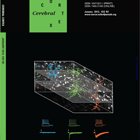
Function of nicotinic receptors uncovered: Rogier Poorthuis and Bernard Bloem, PhD students at the department of Integrative Neurophysiology, published on the mechanisms by which nicotinic acetylcholine receptors regulate synaptic circuits and neuronal excitability in the prefrontal cortex. They show that these processes markedly differ across cortical layers. A 3D illustration of the layered prefrontal cortical network is now selected to be on the cover of Cerebral Cortex
Cholinergic signaling in the Prefrontal Cortex (PFC) plays a key role in attention processes. Different types of receptors process acetylcholine signals. Nicotinic receptors are an important target of acetylcholine in regulating attention. A recent CNCR paper in Science showed that the β2-containing nicotinic receptor controls attention in the PFC. How nicotinic receptors modulate activity in the underlying neuronal network was not yet known and is investigated in the Cerebral Cortex paper.
The PFC is, like all cortical areas, a layered structure. The layers comprise a network of highly interconnected pyramidal and interneurons. Pyramidal neurons are the output neurons of these circuits. Across layers, pyramidal neurons are known to preferentially target different (sub)cortical areas. Hence, nicotinic receptor modulation of these different layers potentially alters different streams of information in the brain. We hypothesized that activation of the PFC by nicotinic receptors would differ across layers.


The cover illustration represents the different layers of the PFC and shows typical pyramidal neurons of all layers, reconstructed by the team of Christiaan de Kock. They are embedded in a network of neurons loaded with a calcium indicator to study neuronal activity using two-photon imaging. Below the nicotinic receptor currents of these neurons are displayed.
Layer-Specific Modulation of the Prefrontal Cortex by Nicotinic Acetylcholine Receptors.
Poorthuis RB*, Bloem B*, Schak B, Wester J, de Kock CP, Mansvelder HD.
Cerebral Cortex. Published Online 2012 Jan 30.
For full article see:
http://cercor.oxfordjournals.org/content/early/2012/01/30/cercor.bhr390.long